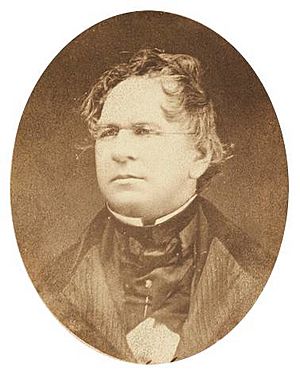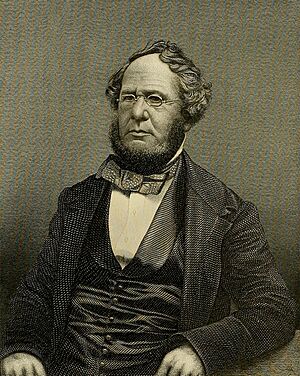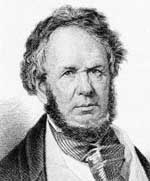Henry Schoolcraft facts for kids
Quick facts for kids
Henry Rowe Schoolcraft
|
|
|---|---|

Photo of Henry Schoolcraft in 1855
|
|
| Born |
Henry Rowe Schoolcraft
March 28, 1793 Guilderland, New York, U.S.
|
| Died | December 10, 1864 (aged 71) Washington, D.C., U.S.
|
| Nationality | American |
| Occupation | geographer, geologist, and ethnologist |
| Spouse(s) | Jane Johnston Mary Howard |
| Signature | |
 |
|
Henry Rowe Schoolcraft (born March 28, 1793 – died December 10, 1864) was an American explorer and scientist. He was a geographer (someone who studies Earth's features), a geologist (someone who studies rocks and the Earth's structure), and an ethnologist (someone who studies different cultures).
Schoolcraft is famous for his early studies of Native American cultures. He also led an important trip in 1832 to find the source of the Mississippi River. Later, in the 1850s, he wrote a huge six-volume book about Native Americans for the US government.
From 1822, he worked as a US Indian agent in Michigan. This job meant he was the government's representative to Native American tribes. During this time, he named many new counties. He often made up new names that he said came from Native American languages.
He married Jane Johnston, whose father was a fur trader and whose mother was the daughter of an Ojibwe war chief. Jane taught Schoolcraft the Ojibwe language and a lot about her culture. She is now known as the first Native American writer in the United States.
Schoolcraft kept studying and writing about Native American tribes. In 1833, he became a member of the American Philosophical Society, a famous group for thinkers and scientists.
After Jane died in 1842, Schoolcraft married Mary Howard in 1847. Mary was from a wealthy family in South Carolina. In 1860, she wrote a popular book called The Black Gauntlet.
Contents
Early Life and Learning
Henry Schoolcraft was born in 1793 in Guilderland, New York. His parents were Lawrence and Margaret-Anne Barbara Schoolcraft. He started Union College when he was 15. He also went to Middlebury College. He was very interested in geology and minerals.
His father made glass, and Henry first worked in that business. He wrote a paper about glassmaking in 1817. After working in glass factories in New York, Vermont, and New Hampshire, Henry left the family business at age 25. He wanted to explore the western parts of the country.
Exploring the Land
From November 1818 to February 1819, Schoolcraft and his friend Levi Pettibone went on a trip. They traveled from Potosi, Missouri, to what is now Springfield. They went further down the White River into Arkansas. They studied the land, rocks, and minerals there.
Schoolcraft wrote about this trip in his book A View of the Lead Mines of Missouri (1819). He correctly guessed that there was a lot of lead in the area. Missouri later became a top state for lead mining. He also wrote Journal of a Tour into the Interior of Missouri and Arkansaw (1821). This was the first written story by a European-American about exploring the Ozarks.
These trips and books caught the eye of John C. Calhoun, the Secretary of War. Calhoun thought Schoolcraft was hardworking and curious. He suggested Schoolcraft join an expedition led by Governor Lewis Cass of Michigan. This trip was to explore the lands around Lake Superior and west to the Mississippi River.
In the spring of 1820, Schoolcraft joined the Cass expedition as a geologist. They traveled almost 2,000 miles (3,200 km) from Detroit. They went along Lake Huron and Lake Superior, then west to the Mississippi River. They followed the river south and then returned to Detroit by Lake Michigan.
Finding the Mississippi's Source
One goal of the 1820 expedition was to find where the Mississippi River began. They went as far upstream as Upper Red Cedar Lake in Minnesota. Because the water was low, they couldn't go further. So, this lake was named the river's headwaters and renamed Cass Lake. Schoolcraft noted that local people said canoes could go further upstream when the water was higher. Schoolcraft wrote about this trip in A Narrative Journal of Travels Through the Northwestern Regions...to the Sources of the Mississippi River (1821).
In 1821, he joined another government trip through Illinois, Indiana, and Ohio. In 1832, he led a second trip to the Mississippi River's headwaters. This time, he arrived earlier in the year when water levels were higher. This allowed him to travel all the way to Lake Itasca.
Marriages and Family Life
Schoolcraft met his first wife, Jane Johnston, in 1822. He had just been sent to Sault Ste. Marie, Michigan, as the first US Indian agent there. The government wanted to have an official presence after the War of 1812.
Jane was the oldest daughter of John Johnston, a well-known fur trader. Her mother, Ozhaguscodaywayquay, was the daughter of a powerful Ojibwe chief, Waubojeeg. Jane's family was important and well-known in the area.
Jane was also called Bamewawagezhikaquay, which means "Woman of the Sound the Stars Make Rushing Through the Sky." She knew a lot about the Ojibwe language and culture. She shared this knowledge with Schoolcraft. Her stories and knowledge later helped Henry Wadsworth Longfellow write his famous poem The Song of Hiawatha.
Jane and Henry had four children:
- William Henry (1824–1827) died young from a sickness called croup.
- A daughter who was stillborn in 1825.
- Jane Susan Ann (1827–1892), called Janee.
- John Johnston (1829–1864), who was hurt in the Civil War and died at age 34.
The Schoolcrafts sent Janee and John to a boarding school in Detroit. Janee, at 11, handled it well, but John, at nine, had a harder time and missed his parents.
Henry and Jane enjoyed writing together. They even made a family magazine. Jane was often sick and died in 1842 while visiting her sister in Canada.
On January 12, 1847, Schoolcraft married Mary Howard in Washington, D.C. She was from a wealthy family in South Carolina. Mary helped Schoolcraft finish his large study of Native Americans. In 1860, she published her novel The Black Gauntlet: A Tale of Plantation Life in South Carolina.
Working as an Indian Agent
Schoolcraft started his ethnological research in 1822. This was when he became the US Indian agent at Sault Ste. Marie, Michigan. He was in charge of tribes in what is now northern Michigan, Wisconsin, and Minnesota. From his wife, Jane Johnston, Schoolcraft learned the Ojibwe language and much about their traditions and culture.
Schoolcraft and Jane created a family magazine called The Muzzeniegun, or Literary Voyager. They made it in the winter of 1826–1827. It had mostly his writings, but also some from Jane and other local people. Even though they only made single issues, they shared them widely. Jane Johnston Schoolcraft used pen names like "Rosa" and Leelinau to write about different parts of Native American culture.
Schoolcraft was elected to the government of the Michigan Territory. He served there from 1828 to 1832. In 1832, he traveled again to the upper Mississippi River. He wanted to help solve problems between the Ojibwe and Dakota nations. He tried to talk to as many Native American leaders as possible to keep the peace. He also helped vaccinate Native Americans against smallpox.
During this trip, Schoolcraft explored the area. He made the first accurate map of the Lake District around western Lake Superior. He found the true source of the Mississippi River in Lake Itasca. He made up the name "Itasca" from Latin words meaning "truth" and "head." The nearby Schoolcraft River was later named after him. Newspapers across the US wrote about this discovery. Schoolcraft wrote his own book about it, Narrative of an Expedition Through the Upper Mississippi River to Itasca Lake (1834).
In 1833, his area of responsibility for Native American affairs grew much larger. Schoolcraft and Jane moved to Mackinac Island, which became his new headquarters. In 1836, he helped settle land disagreements with the Ojibwe. He worked with them to create the Treaty of Washington (1836). Through this treaty, the Ojibwe gave the US government a huge amount of land, over 13 million acres (53,000 km²).
Schoolcraft believed the Ojibwe would be better off learning to farm. He thought they should give up their large hunting lands. The government agreed to pay them and provide supplies to help them change their way of life. However, the government often paid late or not enough, which caused problems for the Ojibwe.
In 1838, Schoolcraft oversaw the building of the Indian Dormitory on Mackinac Island. This building is now on the National Register of Historic Places. It gave temporary homes to Ojibwe people who came to Mackinac Island to get their payments.
In 1839, Schoolcraft became the Superintendent of Indian Affairs for the Northern Department. He started a series of studies about Native Americans. These were later published as Algic Researches (2 vols., 1839). This included many Native American stories and legends. Many of these were told to him or translated by his wife, Jane Johnston Schoolcraft.
While in Michigan, Schoolcraft was also a member of the Board of Regents for the University of Michigan. He helped set up the university's financial system.
Starting Magazines
Schoolcraft started and wrote for the first US journal about public education, called The Journal of Education. He also published The Souvenir of the Lakes, which was the first literary magazine in Michigan.
Naming Places
Schoolcraft named many of Michigan's counties and places. He named Leelanau County, Michigan after his wife's pen name, "Leelinau." For counties created in 1840, he often made up names that sounded Native American. For example, names like Alcona, Algoma, Allegan, Alpena, Arenac, Iosco, Kalkaska, Lenawee, Oscoda and Tuscola were created by Schoolcraft. He combined parts of Native American words with parts of Latin and Arabic words. Lake Itasca, the source of the Mississippi River, is another example of his made-up Native American sounding names.
Later Years
In 1841, the Whig Party came to power. Schoolcraft lost his job as Indian agent. He and Jane moved to New York. Jane died the next year while visiting her sister in Canada. Schoolcraft was traveling in Europe at the time.
He kept writing about Native Americans. In 1846, the US Congress asked him to create a big reference book about American Indian tribes. Schoolcraft asked artist George Catlin to illustrate his book, but Catlin said no. Schoolcraft then hired Seth Eastman, an Army officer known for his paintings of Native American peoples. Eastman had lived among Native American cultures and painted them carefully.
Schoolcraft worked for years on his history and survey of the Indian tribes of the United States. It was published in six volumes from 1851 to 1857. People praised his research and Eastman's detailed illustrations. However, critics also noted that the work was hard to use because it lacked an index and was poorly organized. Almost 100 years later, in 1954, the Smithsonian Institution created an index for the books.
Schoolcraft died in Washington, D.C., on December 10, 1864. After he died, his second wife, Mary, gave over 200 books from his library to the Boston Athenæum. These books were published in 35 different Native American languages. Schoolcraft and Mary are both buried in the Congressional Cemetery in Washington, D.C. His writings are kept at the Library of Congress.
Works
- A View of the Lead-Mines of Missouri (1819)
- Journal of a Tour in the Interior of Missouri and Arkansas (1820)
- Travels from Detroit to the Sources of the Mississippi with an Expedition under Lewis Cass (1821)
- Travels in the Central Portions of Mississippi Valley (1825)
- Narrative of an Expedition Through the Upper Mississippi River to Itasca Lake (1834)
- Algic Researches, a book of Indian allegories and legends (2 vols., 1839)
- Oneota, or Characteristics of the Red Race of America (1844-5)
- Notes on the Iroquois (1846)
- Personal Memoirs of a Residence of Thirty Years with the Indian Tribes on the American Frontiers, 1812 to 1842 (1851)
- Historical and Statistical Information respecting the History, Condition, and Prospects of the Indian Tribes of the United States, with illustrations by Capt. Seth Eastman (6 vols., 1851-7)
- The Myth of Hiawatha, and other Oral Legends (1856).
Honors and Legacy
Many places are named after Henry Schoolcraft, including:
- Schoolcraft County in Michigan.
- Schoolcraft Township in Houghton County, Michigan.
- Schoolcraft Township in Kalamazoo County, Michigan.
- Schoolcraft Township in Hubbard County, Minnesota.
- The Village of Schoolcraft in Kalamazoo County, Michigan.
- Schoolcraft River and Schoolcraft Lake in Minnesota.
- Schoolcraft Island in Lake Itasca, Minnesota.
- U.S. Route 65 near Springfield, Missouri is called the Schoolcraft Freeway.
- Schoolcraft College in Livonia, Michigan is named in his honor.
- Henry R. Schoolcraft Elementary School in Waterford, Michigan is named after him.
- Schoolcraft State Park in Minnesota was created to remember his expeditions.
- The Liberty ship SS Henry R. Schoolcraft was launched in 1943.



